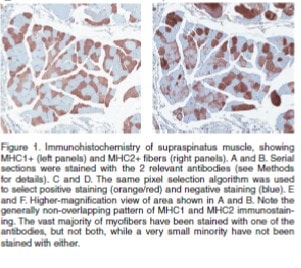Does a New Study Explain Rotator Cuff Tear Healing Time? Full Thickness Rotator Cuff Tears have Lower Regenerative Abilities
A new study just published may help explain the differences in rotator cuff tear healing time. While some partial tears of the rotator cuff will heal on their own, full thickness tears are usually another story, showing a prolonged or infinite healing time (meaning they often don’t heal). Could this be due to a difference in the number of healing stem cells in the area?
A recent study set out to answer that important question. The researchers took tissue samples from 24 patients undergoing rotator cuff repair surgery. They then looked at the cell content of the samples. Almost all of your body’s tissues have both stem cells and progenitor cells (the latter being the older more mature version of a stem cell) that can repair damaged tissue. If these cells weren’t present, your body would begin to fall apart from normal wear and tear (this is described in more detail in our practice’s e-book Orthopedics 2.0). In this case, for full thickness tears there were fewer muscle satellite cells (the muscle version of a more mature stem cell). There were also fewer muscle cells that were actively growing and weaker/thinner muscle fibers being produced by those cells. Partial thickness tears had more of these repair cells, more cells actively growing, and better muscle fibers being produced. This would explain why partial tears heal better-they have more repair cells available to them to help healing.
The upshot? Stem cells and their older cousins (progenitor cells) live in just about every tissue and when there are fewer of them or they are less active, bad things happen (like no or poor healing). This is the one of the main thrusts behind the Orthopedics 2.0 philosophy-supplement areas that aren’t healing by placing more of the patient’s own stem cells there through exacting, image guided, injection. I have blogged on a several cases where we have seen imaging evidence of rotator cuff healing after a stem cell injection. We also have a randomized controlled trial about using same day stem cells to heal torn rotator cuff muscles that we are recruiting for right now.

If you have questions or comments about this blog post, please email us at [email protected]
NOTE: This blog post provides general information to help the reader better understand regenerative medicine, musculoskeletal health, and related subjects. All content provided in this blog, website, or any linked materials, including text, graphics, images, patient profiles, outcomes, and information, are not intended and should not be considered or used as a substitute for medical advice, diagnosis, or treatment. Please always consult with a professional and certified healthcare provider to discuss if a treatment is right for you.

